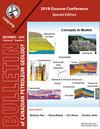阿尔伯塔东北部Upper Elk Point亚群古地理与蒸发岩分布及其对蒸发岩溶蚀、岩溶作用和碳酸盐成岩作用的启示
Q3 Earth and Planetary Sciences
引用次数: 1
摘要
Elk Point上亚组地层和单元的岩石地层对比和绘图提供了阿尔伯塔省范围和分布的最新信息。再加上蒸发岩序列中三种蒸发岩矿物(岩盐、硬石膏和石膏)的详细床层蒸发岩图,这些数据为全省这些单元的古地理提供了新的表示。Keg河、Prairie蒸发岩和Muskeg组的古地理图揭示了阿尔伯塔省北部La Crete次盆地位置的新细节,以及该沉积区内Keg河组建造物和上覆蒸发岩地层的分布和性质。净蒸发岩绘图提供了上Elk Point亚群蒸发岩分布的可靠图像,并允许对非均质性、岩盐溶解和硫酸盐岩溶作用进行详细表征。石膏测绘显示,在阿尔伯塔省东北部的La Crete次盆地内,通过大气降水将硬石膏再水合为石膏(石膏化)最为明显,尤其是在厚硬石膏矿床与Prairie Evaporite岩盐溶解崖以东的建造间盆地区域有关的地方。该组合解释了活动石膏化、溶解和相关岩溶作用发生的位置以及预计发生的位置。石膏化过程,以及最终的硫酸盐溶解过程,是在Prairie蒸发岩组碳酸盐岩中形成多孔脱绿层带的必要条件。去矿化层被认为是含水层单元,已知其有助于泥盆纪来源的高盐度水流入可开采油砂区的矿井。有证据表明,艾伯塔省东北部所有蒸发岩中的岩盐和硫酸盐溶解自上而下。圆形链状岩溶湖可能是草原蒸发岩盐溶解崖以东硫酸盐自上而下岩溶作用的大气降水管道的地表表现,类似于在Wood Buffalo国家公园有充分记录的硫酸盐岩溶区观察到的情况。本文章由计算机程序翻译,如有差异,请以英文原文为准。
Upper Elk Point subgroup paleogeography and evaporite distribution with implications for evaporite dissolution, karstification, and carbonate diagenesis in northeastern Alberta
Lithostratigraphic correlation and mapping of formations and units within the Upper Elk Point subgroup provide updated information on their extent and distribution within the province of Alberta. Together with detailed bed-scale evaporite mapping of three evaporite minerals — halite, anhydrite, and gypsum — within evaporitic successions for net-thickness maps, these data allow new representations of the paleogeography of these units across the province. Paleogeographic maps of the Keg River, Prairie Evaporite and Muskeg formations reveal new details on the location of the La Crete sub-basin in northern Alberta, and the distribution and nature of Keg River Formation buildups and the overlying evaporite strata within this depositional realm. Net-evaporite mapping gives a robust picture of the distribution of Upper Elk Point subgroup evaporites, and allows for a detailed characterization of heterogeneities, halite dissolution, and sulphate karstification. Mapping of gypsum reveals that rehydration of anhydrite to gypsum (gypsification) through meteoric inflow is most pronounced within the La Crete sub-basin in northeastern Alberta, particularly where thick anhydrite deposits are associated with interbuildup basinal areas east of the Prairie Evaporite halite dissolution scarp. This association provides an explanation for the location of where active gypsification, dissolution and associated karstification is occurring and where it can be expected to occur. The process of gypsification, and ultimately sulphate dissolution, is requisite for the formation of porous dedolomite zones within the carbonates of the Prairie Evaporite Formation. Dedolomitized beds are recognized as aquifer units that are known to have contributed to Devonian-sourced, high-salinity water inflows to mine pits in the mineable oil sands area. Evidence is provided for a top-down advancement of halite and sulphate dissolution in all evaporites in northeastern Alberta. Circular, chain-like karst lakes are likely surficial expressions of the meteoric conduits for top-down karstification of sulphates east of the Prairie Evaporite halite dissolution scarp, similar to that observed in the well-documented sulphate karst district of Wood Buffalo National Park.
求助全文
通过发布文献求助,成功后即可免费获取论文全文。
去求助
来源期刊

Bullentin of Canadian Petroleum Geology
Earth and Planetary Sciences-Geochemistry and Petrology
CiteScore
2.50
自引率
0.00%
发文量
0
期刊介绍:
The Bulletin of Canadian Petroleum Geology is a peer-reviewed scientific journal published four times a year. Founded in 1953, the BCPG aims to be the journal of record for papers dealing with all aspects of petroleum geology, broadly conceived, with a particularly (though not exclusively) Canadian focus. International submissions are encouraged, especially where a connection can be made to Canadian examples.
 求助内容:
求助内容: 应助结果提醒方式:
应助结果提醒方式:


